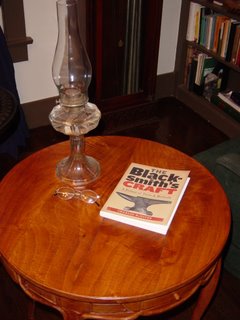 This past weekend saw the opening of the Renaissance Faire at Santa Fe Dam in Irwindale, California, and I spent the whole day with friends at the St. Andrew's encampment Blacksmith shop. Not only did I get a lot of hands-on forge time, and same great corrective advice from the two more experienced boyos who built the forge, I had a problem solved for me with one quick demo.
This past weekend saw the opening of the Renaissance Faire at Santa Fe Dam in Irwindale, California, and I spent the whole day with friends at the St. Andrew's encampment Blacksmith shop. Not only did I get a lot of hands-on forge time, and same great corrective advice from the two more experienced boyos who built the forge, I had a problem solved for me with one quick demo. I had been making a series of hooks, to sink into wood and hold stuff -- like hanging plants or tools and the like. But I was using a plain right angle on the hooks, or sometimes an obtuse angle to transfer some of the hanging weight against the vertical surface instead of pulling the spike out.
It worked, but it wasn't very interesting or decorative.
After about 15 minutes of verbal explanation, I finally copped to the fact that I didn't understand the description I was getting. One 30-second demo later, and I knew exactly how to add the extra little touch with ease, and still use my special angle.
Later I want to try out a wooden bending jig -- which seems like a bad idea
 given that hot metal sets the wood aflame instantly when touched. But I intend to set up a scroll pattern using various diameter nails, and do a series of intricate bends roughly through the nails then fix the details. The wooden-jig should allow me to experiment easily with pin placement, changing the location or diameter of a pending post quickly and easily.
given that hot metal sets the wood aflame instantly when touched. But I intend to set up a scroll pattern using various diameter nails, and do a series of intricate bends roughly through the nails then fix the details. The wooden-jig should allow me to experiment easily with pin placement, changing the location or diameter of a pending post quickly and easily.If I need to have a stable and hot-iron proof jig, I will simply drill out the nail holes through a piece of flat or angle iron, slide the appropriate nails into place et viola, a proper metal jig. Not sure how to secure them yet, but this could be accomplished any number of ways, from a high temp cement to a quick spot weld. So I might have to experiment on that too.
No comments:
Post a Comment